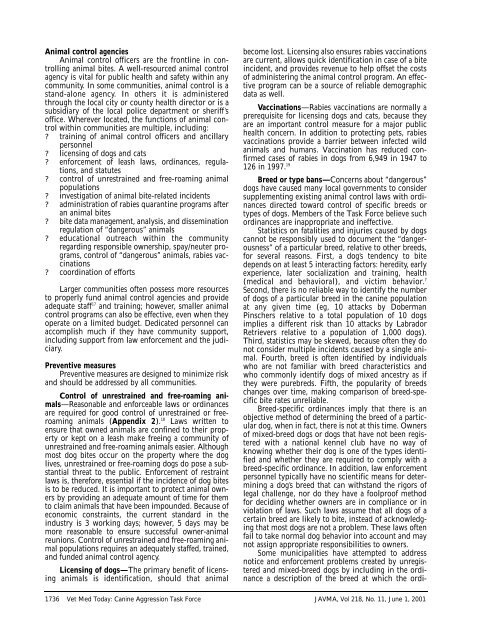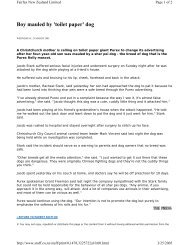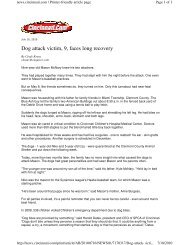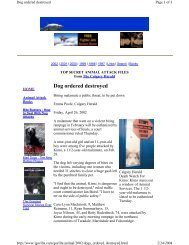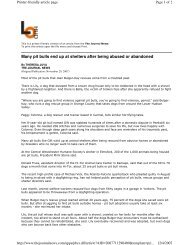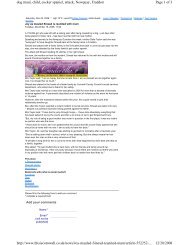A community approach to dog bite prevention - American Veterinary ...
A community approach to dog bite prevention - American Veterinary ...
A community approach to dog bite prevention - American Veterinary ...
Create successful ePaper yourself
Turn your PDF publications into a flip-book with our unique Google optimized e-Paper software.
Animal control agencies<br />
Animal control officers are the frontline in controlling<br />
animal <strong>bite</strong>s. A well-resourced animal control<br />
agency is vital for public health and safety within any<br />
<strong>community</strong>. In some communities, animal control is a<br />
stand-alone agency. In others it is administered<br />
through the local city or county health direc<strong>to</strong>r or is a<br />
subsidiary of the local police department or sheriff’s<br />
office. Wherever located, the functions of animal control<br />
within communities are multiple, including:<br />
? training of animal control officers and ancillary<br />
personnel<br />
? licensing of <strong>dog</strong>s and cats<br />
? enforcement of leash laws, ordinances, regulations,<br />
and statutes<br />
? control of unrestrained and free-roaming animal<br />
populations<br />
? investigation of animal <strong>bite</strong>-related incidents<br />
? administration of rabies quarantine programs after<br />
an animal <strong>bite</strong>s<br />
? <strong>bite</strong> data management, analysis, and dissemination<br />
regulation of “dangerous” animals<br />
? educational outreach within the <strong>community</strong><br />
regarding responsible ownership, spay/neuter programs,<br />
control of “dangerous” animals, rabies vaccinations<br />
? coordination of efforts<br />
Larger communities often possess more resources<br />
<strong>to</strong> properly fund animal control agencies and provide<br />
adequate staff 17 and training; however, smaller animal<br />
control programs can also be effective, even when they<br />
operate on a limited budget. Dedicated personnel can<br />
accomplish much if they have <strong>community</strong> support,<br />
including support from law enforcement and the judiciary.<br />
Preventive measures<br />
Preventive measures are designed <strong>to</strong> minimize risk<br />
and should be addressed by all communities.<br />
Control of unrestrained and free-roaming animals—Reasonable<br />
and enforceable laws or ordinances<br />
are required for good control of unrestrained or freeroaming<br />
animals (Appendix 2). 18 Laws written <strong>to</strong><br />
ensure that owned animals are confined <strong>to</strong> their property<br />
or kept on a leash make freeing a <strong>community</strong> of<br />
unrestrained and free-roaming animals easier. Although<br />
most <strong>dog</strong> <strong>bite</strong>s occur on the property where the <strong>dog</strong><br />
lives, unrestrained or free-roaming <strong>dog</strong>s do pose a substantial<br />
threat <strong>to</strong> the public. Enforcement of restraint<br />
laws is, therefore, essential if the incidence of <strong>dog</strong> <strong>bite</strong>s<br />
is <strong>to</strong> be reduced. It is important <strong>to</strong> protect animal owners<br />
by providing an adequate amount of time for them<br />
<strong>to</strong> claim animals that have been impounded. Because of<br />
economic constraints, the current standard in the<br />
industry is 3 working days; however, 5 days may be<br />
more reasonable <strong>to</strong> ensure successful owner-animal<br />
reunions. Control of unrestrained and free-roaming animal<br />
populations requires an adequately staffed, trained,<br />
and funded animal control agency.<br />
Licensing of <strong>dog</strong>s—The primary benefit of licensing<br />
animals is identification, should that animal<br />
become lost. Licensing also ensures rabies vaccinations<br />
are current, allows quick identification in case of a <strong>bite</strong><br />
incident, and provides revenue <strong>to</strong> help offset the costs<br />
of administering the animal control program. An effective<br />
program can be a source of reliable demographic<br />
data as well.<br />
Vaccinations—Rabies vaccinations are normally a<br />
prerequisite for licensing <strong>dog</strong>s and cats, because they<br />
are an important control measure for a major public<br />
health concern. In addition <strong>to</strong> protecting pets, rabies<br />
vaccinations provide a barrier between infected wild<br />
animals and humans. Vaccination has reduced confirmed<br />
cases of rabies in <strong>dog</strong>s from 6,949 in 1947 <strong>to</strong><br />
126 in 1997. 19<br />
Breed or type bans—Concerns about “dangerous”<br />
<strong>dog</strong>s have caused many local governments <strong>to</strong> consider<br />
supplementing existing animal control laws with ordinances<br />
directed <strong>to</strong>ward control of specific breeds or<br />
types of <strong>dog</strong>s. Members of the Task Force believe such<br />
ordinances are inappropriate and ineffective.<br />
Statistics on fatalities and injuries caused by <strong>dog</strong>s<br />
cannot be responsibly used <strong>to</strong> document the “dangerousness”<br />
of a particular breed, relative <strong>to</strong> other breeds,<br />
for several reasons. First, a <strong>dog</strong>’s tendency <strong>to</strong> <strong>bite</strong><br />
depends on at least 5 interacting fac<strong>to</strong>rs: heredity, early<br />
experience, later socialization and training, health<br />
(medical and behavioral), and victim behavior. 7<br />
Second, there is no reliable way <strong>to</strong> identify the number<br />
of <strong>dog</strong>s of a particular breed in the canine population<br />
at any given time (eg, 10 attacks by Doberman<br />
Pinschers relative <strong>to</strong> a <strong>to</strong>tal population of 10 <strong>dog</strong>s<br />
implies a different risk than 10 attacks by Labrador<br />
Retrievers relative <strong>to</strong> a population of 1,000 <strong>dog</strong>s).<br />
Third, statistics may be skewed, because often they do<br />
not consider multiple incidents caused by a single animal.<br />
Fourth, breed is often identified by individuals<br />
who are not familiar with breed characteristics and<br />
who commonly identify <strong>dog</strong>s of mixed ancestry as if<br />
they were purebreds. Fifth, the popularity of breeds<br />
changes over time, making comparison of breed-specific<br />
<strong>bite</strong> rates unreliable.<br />
Breed-specific ordinances imply that there is an<br />
objective method of determining the breed of a particular<br />
<strong>dog</strong>, when in fact, there is not at this time. Owners<br />
of mixed-breed <strong>dog</strong>s or <strong>dog</strong>s that have not been registered<br />
with a national kennel club have no way of<br />
knowing whether their <strong>dog</strong> is one of the types identified<br />
and whether they are required <strong>to</strong> comply with a<br />
breed-specific ordinance. In addition, law enforcement<br />
personnel typically have no scientific means for determining<br />
a <strong>dog</strong>’s breed that can withstand the rigors of<br />
legal challenge, nor do they have a foolproof method<br />
for deciding whether owners are in compliance or in<br />
violation of laws. Such laws assume that all <strong>dog</strong>s of a<br />
certain breed are likely <strong>to</strong> <strong>bite</strong>, instead of acknowledging<br />
that most <strong>dog</strong>s are not a problem. These laws often<br />
fail <strong>to</strong> take normal <strong>dog</strong> behavior in<strong>to</strong> account and may<br />
not assign appropriate responsibilities <strong>to</strong> owners.<br />
Some municipalities have attempted <strong>to</strong> address<br />
notice and enforcement problems created by unregistered<br />
and mixed-breed <strong>dog</strong>s by including in the ordinance<br />
a description of the breed at which the ordi-<br />
1736 Vet Med Today: Canine Aggression Task Force JAVMA, Vol 218, No. 11, June 1, 2001


